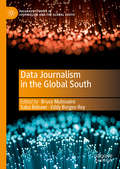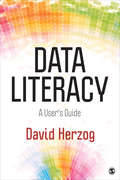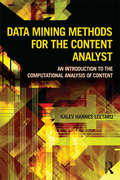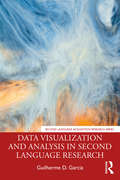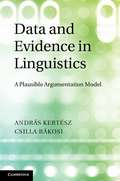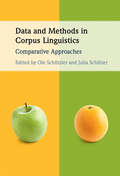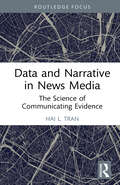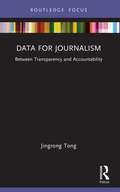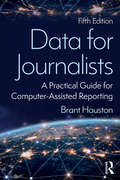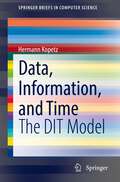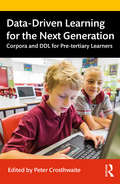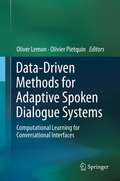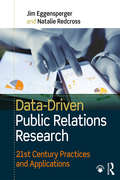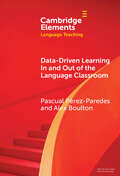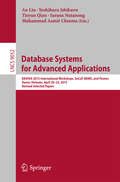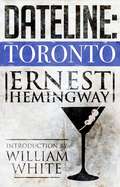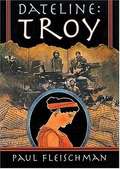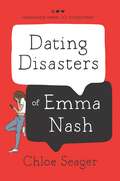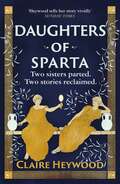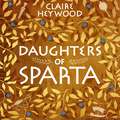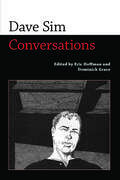- Table View
- List View
Data Journalism in the Global South (Palgrave Studies in Journalism and the Global South)
by Saba Bebawi Bruce Mutsvairo Eddy Borges-ReyThis volume seeks to analyse the emerging wave of data journalism in the Global South. It does so by examining trends, developments and opportunities for data journalism in the aforementioned contexts. Whilst studies in this specific form of journalism are increasing in numbers and significance, there remains a dearth of literature on data journalism in less developed regions of the world. By demonstrating an interest in data journalism across countries including Chile, Argentina, the Philippines, South Africa and Iran, among others, this volume contributes to multifaceted transnational debates on journalism, and is a crucial reference text for anyone interested in data journalism in the ‘developing’ world. Drawing on a range of voices from different fields and nations, sharing empirical and theoretical experiences, the volume aims to initiate a global dialogue among journalism practitioners, researchers and students.
Data Literacy: A User′s Guide
by David L. HerzogA practical, skill-based introduction to data analysis and literacy We are swimming in a world of data, and this handy guide will keep you afloat while you learn to make sense of it all. In Data Literacy: A User′s Guide, David Herzog, a journalist with a decade of experience using data analysis to transform information into captivating storytelling, introduces students and professionals to the fundamentals of data literacy, a key skill in today’s world. Assuming the reader has no advanced knowledge of data analysis or statistics, this book shows how to create insight from publicly-available data through exercises using simple Excel functions. Extensively illustrated, step-by-step instructions within a concise, yet comprehensive, reference will help readers identify, obtain, evaluate, clean, analyze and visualize data. A concluding chapter introduces more sophisticated data analysis methods and tools including database managers such as Microsoft Access and MySQL and standalone statistical programs such as SPSS, SAS and R.
Data Literacy: A User′s Guide
by David L. HerzogA practical, skill-based introduction to data analysis and literacy We are swimming in a world of data, and this handy guide will keep you afloat while you learn to make sense of it all. In Data Literacy: A User′s Guide, David Herzog, a journalist with a decade of experience using data analysis to transform information into captivating storytelling, introduces students and professionals to the fundamentals of data literacy, a key skill in today’s world. Assuming the reader has no advanced knowledge of data analysis or statistics, this book shows how to create insight from publicly-available data through exercises using simple Excel functions. Extensively illustrated, step-by-step instructions within a concise, yet comprehensive, reference will help readers identify, obtain, evaluate, clean, analyze and visualize data. A concluding chapter introduces more sophisticated data analysis methods and tools including database managers such as Microsoft Access and MySQL and standalone statistical programs such as SPSS, SAS and R.
Data Mining Methods for the Content Analyst: An Introduction to the Computational Analysis of Content (Routledge Communication Series)
by Kalev LeetaruWith continuous advancements and an increase in user popularity, data mining technologies serve as an invaluable resource for researchers across a wide range of disciplines in the humanities and social sciences. In this comprehensive guide, author and research scientist Kalev Leetaru introduces the approaches, strategies, and methodologies of current data mining techniques, offering insights for new and experienced users alike. Designed as an instructive reference to computer-based analysis approaches, each chapter of this resource explains a set of core concepts and analytical data mining strategies, along with detailed examples and steps relating to current data mining practices. Every technique is considered with regard to context, theory of operation and methodological concerns, and focuses on the capabilities and strengths relating to these technologies. In addressing critical methodologies and approaches to automated analytical techniques, this work provides an essential overview to a broad innovative field.
Data Visualization and Analysis in Second Language Research (Second Language Acquisition Research Series)
by Guilherme D. GarciaThis introduction to visualization techniques and statistical models for second language research focuses on three types of data (continuous, binary, and scalar), helping readers to understand regression models fully and to apply them in their work. Garcia offers advanced coverage of Bayesian analysis, simulated data, exercises, implementable script code, and practical guidance on the latest R software packages. The book, also demonstrating the benefits to the L2 field of this type of statistical work, is a resource for graduate students and researchers in second language acquisition, applied linguistics, and corpus linguistics who are interested in quantitative data analysis.
Data Visualization in Enlightenment Literature and Culture
by Ileana BairdData Visualization in Enlightenment Literature and Culture explores the new interpretive possibilities offered by using data visualization in eighteenth-century studies. Such visualizations include tabulations, charts, k-means clustering, topic modeling, network graphs, data mapping, and/or other illustrations of patterns of social or intellectual exchange. The contributions to this collection present groundbreaking research of texts and/or cultural trends emerging from data mined from existing databases and other aggregates of sources. Describing both small and large digital projects by scholars in visual arts, history, musicology, and literary studies, this collection addresses the benefits and challenges of employing digital tools, as well as their potential use in the classroom.Chapters 1, 3, 8 and 10 are available open access under a Creative Commons Attribution 4.0 International License via link.springer.com.
Data and Evidence in Linguistics
by András Kertész Csilla RákosiThe question of what types of data and evidence can be used is one of the most important topics in linguistics. This book is the first to comprehensively present the methodological problems associated with linguistic data and evidence. Its originality is twofold. First, the authors' approach accounts for a series of unexplained characteristics of linguistic theorising: the uncertainty and diversity of data, the role of evidence in the evaluation of hypotheses, the problem solving strategies as well as the emergence and resolution of inconsistencies. Second, the findings are obtained by the application of a new model of plausible argumentation which is also of relevance from a general argumentation theoretical point of view. All concepts and theses are systematically introduced and illustrated by a number of examples from different linguistic theories, and a detailed case-study section shows how the proposed model can be applied to specific linguistic problems.
Data and Methods in Corpus Linguistics: Comparative Approaches
by Julia Schlüter Ole SchützlerCorpus linguistics continues to be a vibrant methodology applied across highly diverse fields of research in the language sciences. With the current steep rise in corpus sizes, computational power, statistical literacy and multi-purpose software tools, and inspired by neighbouring disciplines, approaches have diversified to an extent that calls for an intensification of the accompanying critical debate. Bringing together a team of leading experts, this book follows a unique design, comparing advanced methods and approaches current in corpus linguistics, to stimulate reflective evaluation and discussion. Each chapter explores the strengths and weaknesses of different datasets and techniques, presenting a case study and allowing readers to gauge methodological options in practice. Contributions also provide suggestions for further reading, and data and analysis scripts are included in an online appendix. This is an important and timely volume, and will be essential reading for any linguist interested in corpus-linguistic approaches to variation and change.
Data and Narrative in News Media: The Science of Communicating Evidence (Routledge Focus on Journalism Studies)
by Hai L. TranBringing together research from across media and psychology disciplines, this book provides an understanding of the impact of using qualitative and quantitative forms of evidence in the news.Drawing on previous studies with seemingly contradictory conclusions, the author proposes an integrative framework that explains the differential roles of data and narrative in evidence-based communication, as well as the potential for their combination. Bridging theory and practice, this book delves into the specific conditions and key factors influencing information processing, combining interdisciplinary scholarship from fields of media effects, persuasion, and cognitive psychology. It emphasizes the importance of incorporating numerical and story elements into journalism through scientific methods, underlining the effects on audience responses according to cognitive-experiential theory. Written accessibly and weaving in contemporary examples and data from around the world, this book expands our understanding of why certain qualitative and quantitative forms of evidence turn out to be (in)effective, translating these findings into take-away lessons to inform more thoughtful news writing and production.Data and Narrative in News Media is a versatile resource for researchers and scholars with an interest in media effects and the presentation of news.
Data for Journalism: Between Transparency and Accountability (Disruptions)
by Jingrong TongConsidering the interactions between developments in open data and data journalism, Data for Journalism: Between Transparency and Accountability offers an interdisciplinary account of this complex and uncertain relationship in a context of tightening the control over data and weighing transparency against privacy. As data has brought both promise and disruptive changes to societies, the relationship between transparency and accountability has become complicated, and data journalism is practised alongside the contradictory needs of opening up and protecting data. In addition to exploring the benefits of data for journalism, this book addresses the uncertain nature of data and the obstacles preventing data from being fluently accessed and properly used for data reporting. Because of these obstacles, it argues individual data journalists play a decisive role in using data for journalism and facilitating the circulation of data. Frictions in data access, newsrooms’ resources and cultures and data journalists’ skill and data literacy levels determine the degree to which journalism can benefit from data, and these factors potentially exacerbate digital inequalities between newsrooms in different countries and with different resources. As such, the author takes an international perspective, drawing on empirical research and cases from around the world, including countries such as the UK, the US, Germany, Sweden, Australia, India, China and Japan. Introducing a new dimension to the study of developments in journalism and the role of journalism in society, Data for Journalism will be of interest to academics and researchers in the fields of journalism and the sociology of (big and open) data.
Data for Journalists: A Practical Guide for Computer-Assisted Reporting
by Brant HoustonThis straightforward and effective how-to guide provides the basics for any reporter or journalism student beginning to use data for news stories. It has step-by-step instructions on how to do basic data analysis in journalism while addressing why these digital tools should be an integral part of reporting in the 21st century. In an ideal core text for courses on data-driven journalism or computer-assisted reporting, Houston emphasizes that journalists are accountable for the accuracy and relevance of the data they acquire and share. With a refreshed design, this updated new edition includes expanded coverage on social media, scraping data from the web, and text-mining, and provides journalists with the tips and tools they need for working with data.
Data, Information, and Time: The DIT Model (SpringerBriefs in Computer Science)
by Hermann KopetzThis SpringerBrief presents the data- information-and-time (DIT) model that precisely clarifies the semantics behind the terms data, information and their relations to the passage of real time. According to the DIT model a data item is a symbol that appears as a pattern (e.g., visual, sound, gesture, or any bit pattern) in physical space. It is generated by a human or a machine in the current contextual situation and is linked to a concept in the human mind or a set of operations of a machine. An information item delivers the sense or the idea that a human mind extracts out of a given natural language proposition that contains meaningful data items. Since the given tangible, intangible and temporal context are part of the explanation of a data item, a change of context can have an effect on the meaning of data and the sense of a proposition. The DIT model provides a framework to show how the flow of time can change the truth-value of a proposition. This book compares our notions of data, information, and time in differing contexts: in human communication, in the operation of a computer system and in a biological system. In the final Section a few simple examples demonstrate how the lessons learned from the DIT-model can help to improve the design of a computer system.
Data-Driven Learning for the Next Generation: Corpora and DDL for Pre-tertiary Learners
by Peter CrosthwaiteDespite advancements in and availability of corpus software in language classrooms facilitating data-driven learning (DDL), the use of such methods with pre-tertiary learners remains rare. This book specifically explores the affordances of DDL for younger learners, testing its viability with teachers and students at the primary and secondary years of schooling. It features eminent and up-and-coming researchers from Europe, Asia, and Australasia who seek to address best practice in implementing DDL with younger learners, while providing a wealth of empirical findings and practical DDL activities ready for use in the pre-tertiary classroom. Divided into three parts, the volume's first section focuses on overcoming emerging challenges for DDL with younger learners, including where and how DDL can be integrated into pre-tertiary curricula, as well as potential barriers to this integration. It then considers new, cutting-edge innovations in corpora and corpus software for use with younger learners in the second section, before reporting on actual DDL studies performed with younger learners (and/or their teachers) at the primary and secondary levels of education. This book will appeal to post-graduate students, academics and researchers with interests in corpus linguistics, second language acquisition, primary and secondary literacy education, and language and educational technologies.
Data-Driven Methods for Adaptive Spoken Dialogue Systems: Computational Learning for Conversational Interfaces
by Oliver Lemon Olivier PietquinData driven methods have long been used in Automatic Speech Recognition (ASR) and Text-To-Speech (TTS) synthesis and have more recently been introduced for dialogue management, spoken language understanding, and Natural Language Generation. Machine learning is now present "end-to-end" in Spoken Dialogue Systems (SDS). However, these techniques require data collection and annotation campaigns, which can be time-consuming and expensive, as well as dataset expansion by simulation. In this book, we provide an overview of the current state of the field and of recent advances, with a specific focus on adaptivity.
Data-Driven Public Relations Research: 21st Century Practices and Applications
by Jim Eggensperger Natalie RedcrossThe public relations industry is undergoing a revolution in using data to define promotional programs, to measure influence and to address the needs of clients with more precision than ever. Applying tools that range from online surveys to social-media listening to applying big data with sophisticated algorithms, today’s PR professionals are data-driven in virtually everything they do. Data-Driven Public Relations Research is the first book for PR students and practitioners to offer an overview of these new practices as well as a glimpse into the future of these new applications, including "big data" and some of the applications from real-world PR campaigns and strategic planning. It includes contemporary cases involving brand name companies who are blazing new trails in the use of metrics in public relations. This book presents a practical, accessible approach that requires no prior training or experience, with easy to follow, step-by-step measurement examples from existing campaigns. Using Excel, the book enables readers to export lessons from the classroom to the office, where use of statistical packages is rare and can give PR practitioners the advantage over competitors. This pragmatic approach helps readers apply metrics to PR problems such as: Finding the best target audiences Understanding audience communication needs and preferences How best to present research outcomes How to manage major projects with specialized research firms. Accompanying electronic resources for the book include sample answers to the book’s discussion questions, PowerPoint lecture slides for instructors and sample research exercises using Excel.
Data-driven Learning in and out of the Language Classroom (Elements in Language Teaching)
by Pascual Pérez-Paredes Alex BoultonData-Driven Learning (DDL) can be broadly defined as the use of corpus tools and techniques for learners and teachers of foreign or second language, typically in the form of concordances derived from authentic texts for inductive learning of lexicogrammar. This Element is a practical guide for language teachers and graduate students intending to explore or upgrade their use of corpora in the language classroom and beyond. In today's context, where advances in computing and information processing dominate our social and professional interactions, the use of corpora emerges as a prime resource with which to approach data-driven language learning and teaching, developing language awareness, noticing skills and critical thinking for learning that generative AI cannot do for you.
Database Systems for Advanced Applications: DASFAA 2015 International Workshops, SeCoP, BDMS, and Posters, Hanoi, Vietnam, April 20-23, 2015, Revised Selected Papers (Lecture Notes in Computer Science #9052)
by An Liu Yoshiharu Ishikawa Tieyun Qian Sarana Nutanong Muhammad Aamir CheemaDASFAA is an annual international database conference, located in the Asia-Pacific region,which show cases state-of-the-art R & D activities in databases-terms and their applications. It provides a forum for technical presentations and discussions among database researchers, developers and users from academia, business and industry. DASFAA 2015 the 20th in the series, was held during April 20-23, 2015 in Hanoi, Vietnam. In this year, we carefully selected two workshops, each focusing on specific research issues that contribute to the main themes of the DASFAA conference. This volume contains the final versions of papers accepted for the two workshops: Second International Workshop on Semantic Computing and Personalization (SeCoP 2015); Second International Workshop on Big Data Management and Service (BDMS 2015); and a Poster Session. [All the workshops were selected via a public call-for-proposals process. The workshop organizers put a tremendous amount of effort into soliciting and - lecting papers with a balance of high quality, new ideas and new applications. We asked all workshops to follow a rigid paper selection process, including the procedure to ensure that any Program Committee members are excluded from the paper review process of any paper they are involved with. A requirement about the overall paper acceptance rate of no more than 50% was also imposed on all the workshops. ]
Dateline: Toronto
by Ernest HemingwayDateline: Toronto collects all 172 pieces that Hemingway published in the Star, including those under pseudonyms. Hemingway readers will discern his unique voice already present in many of these pieces, particularly his knack for dialogue. It is also fascinating to discover early reportorial accounts of events and subjects that figure in his later fiction. As William White points out in his introduction to this work, "Much of it, over sixty years later, can still be read both as a record of the early twenties and as evidence of how Ernest Hemingway learned the craft of writing." The enthusiasm, wit, and skill with which these pieces were written guarantee that Dateline: Toronto will be read for pleasure, as excellent journalism, and for the insights it gives to Hemingway's works.
Dateline: Troy
by Paul FleischmanA retelling of the story of the Trojan War illustrated with collages featuring newspaper clippings of modern events from World War I through the Persian Gulf war.
Dating Disasters of Emma Nash
by Chloe SeagerDon’t miss the laugh-out-loud novel of the year!Online, you can choose who you want to be. If only real life were so easy…Emma Nash may be down, but after months of wallowing, stalking her ex online and avoiding showering—because, really, who’s going to care?—Emma’s ready to own her newly single status, get out with her friends and chronicle her dating adventures on her private blog.But life online doesn’t always run smoothly. Stumbling upon her mother’s Tinder dating profile, getting catfished and accidentally telling the entire world why her ex-boyfriend Leon’s not worth any girl’s…um…time… Okay, those were disasters.But surely nothing else can go wrong?Filled with fun, flirty encounters and heartwarming friendships, Dating Disasters of Emma Nash will shock and delight scores of readers looking for something fresh.
Daughters of Durga: Dowries, Gender Violence and Family in Australia
by Manjula Datta O'ConnorIn the early 2010s a spate of domestic violence-related murders in the Victorian Indian community compelled psychiatrist Manjula Datta O'Connor to investigate the causes of patriarchal abuse in South Asian families. As a practitioner with many decades experience in the field, Datta O'Connor questioned whether a better understanding of history and culture could help these communities implement measures to prevent family violence. But the most powerful lessons came from those she met through her practice - survivors of transnational abuse and of sexual and dowry exploitation. These women taught Datta O'Connor about human resilience and strength and the myriad ways women find the inner power to survive. These are the daughters of the goddess Durga, wielding the tools of history to produce meaningful change.
Daughters of Sparta: A tale of secrets, betrayal and revenge from mythology's most vilified women
by Claire HeywoodTwo sisters parted. Two women blamed. Two stories reclaimed.'Required reading for fans of Circe . . . a remarkable, thrilling debut' - Fiona Davis, New York Times bestselling author of The Lions of Fifth Avenue'Fluent and persuasive. I admire the ambition with which Heywood tackles the subject, to which she brings freshness and verve. I enjoyed it very much' - Elizabeth Buchan, bestselling author of The Museum of Broken PromisesFor millennia, two women have been blamed for the fall of a mighty civilisation - but now it's time to hear their side of the story . . .As princesses of Sparta, Helen and Klytemnestra have known nothing but luxury and plenty. With their high birth and unrivalled beauty, they are the envy of all of Greece.Such privilege comes at a high price, though, and their destinies are not theirs to command. While still only girls they are separated and married off to legendary foreign kings Agamemnon and Menelaos, never to meet again. Their duty is now to give birth to the heirs society demands and be the meek, submissive queens their men expect.But when the weight of their husbands' neglect, cruelty and ambition becomes too heavy to bear, they must push against the constraints of their sex to carve new lives for themselves - and in doing so make waves that will ripple throughout the next three thousand years.Perfect for readers of Circe and Ariadne, Daughters of Sparta is a vivid and illuminating retelling of the Siege of Troy that tells the story of mythology's most vilified women from their own mouths at long last.Helen of Troy and her sister Klytemnestra are reimagined in this gorgeous retelling of the classic Greek myth - not as women defined by their husbands and lovers but as battle-weary survivors of a patriarchal society who take control of their own destiny. Absolutely riveting!' - Alka Joshi, New York Times bestselling author of The Henna Artist
Daughters of Sparta: A tale of secrets, betrayal and revenge from mythology's most vilified women
by Claire HeywoodThe story of the Siege of Troy from the infamous Helen and her sister Klytemnestra's points of view - a tale of secrets, passion and revenge from the women behind mythology's most devastating war.Two sisters parted. Two women blamed. Two stories reclaimed.'Required reading for fans of Circe . . . a remarkable, thrilling debut' - Fiona Davis, New York Times bestselling author of The Lions of Fifth AvenueFor millennia, two women have been blamed for the fall of a mighty civilisation - but now it's time to hear their side of the story . . .As princesses of Sparta, Helen and Klytemnestra have known nothing but luxury and plenty. With their high birth and unrivalled beauty, they are the envy of all of Greece.Such privilege comes at a high price, though, and their destinies are not theirs to command. While still only girls they are separated and married off to legendary foreign kings Agamemnon and Menelaus, never to meet again. Their duty is now to give birth to the heirs society demands and be the meek, submissive queens their men expect.But when the weight of their husbands' neglect, cruelty and ambition becomes too heavy to bear, they must push against the constraints of their sex to carve new lives for themselves - and in doing so make waves that will ripple throughout the next three thousand years.Perfect for readers of Circe and Ariadne, Daughters of Sparta is a vivid and illuminating retelling of the Siege of Troy that tells the story of mythology's most vilified women from their own mouths at long last.Helen of Troy and her sister Klytemnestra are reimagined in this gorgeous retelling of the classic Greek myth - not as women defined by their husbands and lovers but as battle-weary survivors of a patriarchal society who take control of their own destiny. Absolutely riveting!' - Alka Joshi, New York Times bestselling author of The Henna Artist(P) 2021 Hodder & Stoughton Ltd
Dave Sim: Conversations (Conversations with Comic Artists Series)
by Eric Hoffman Dominick GraceIn 1977, Dave Sim (b. 1956) began to self-publish Cerebus, one of the earliest and most significant independent comics, which ran for 300 issues and ended, as Sim had planned from early on, in 2004. Over the run of the comic, Sim used it as a springboard to explore not only the potential of the comics medium but also many of the core assumptions of Western society. Through it he analyzed politics, the dynamics of love, religion, and, most controversially, the influence of feminism—which Sim believes has had a negative impact on society. Moreover, Sim inserted himself squarely into the comic as Cerebus's creator, thereby inviting criticism not only of the creation, but also of the creator. What few interviews Sim gave often pushed the limits of what an interview might be in much the same way that Cerebus pushed the limits of what a comic might be. In interviews Sim is generous, expansive, provocative, and sometimes even antagonistic. Regardless of mood, he is always insightful and fascinating. His discursive style is not conducive to the sound bite or to easy summary. Many of these interviews have been out of print for years. And, while the interviews range from very general, career-spanning explorations of his complex work and ideas, to tightly focused discussions on specific details of Cerebus, all the interviews contained herein are engaging and revealing.
David Adams Richards of the Miramichi
by Tony TremblayWidely considered to be one of Canada's most important authors, David Adams Richards has been honoured with a Giller Prize and two Governor General's Literary Awards. Despite this, there has been a dearth of critical appraisal of his life and works. In David Adams Richards of the Miramichi, Tony Tremblay sheds light not only on Richards' art and achievements, but also on Canadian literary criticism in general.Tremblay maps out the early influences on Richards' thinking and writing by drawing on interviews, archival records, and cultural studies of New Brunswick. He argues that the author is a more sophisticated craftsman than his critical reception has assumed and makes the case for a more nuanced analysis of his works. Equal parts literary biography, literary criticism, and cultural study of New Brunswick, David Adams Richards of the Miramichi provides a rare glimpse into the struggles and triumphs of a New Brunswick artist in a national and provincial milieu.
